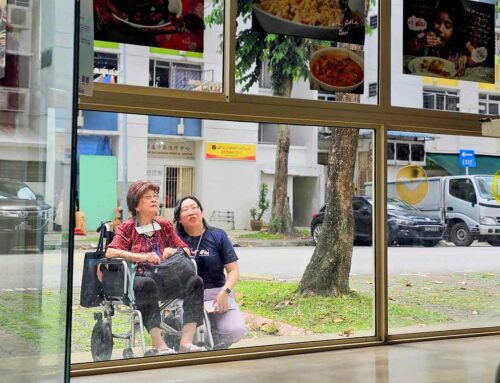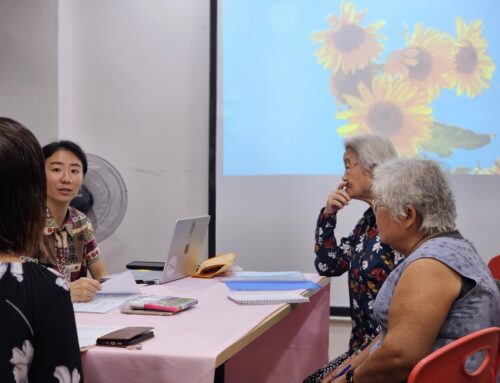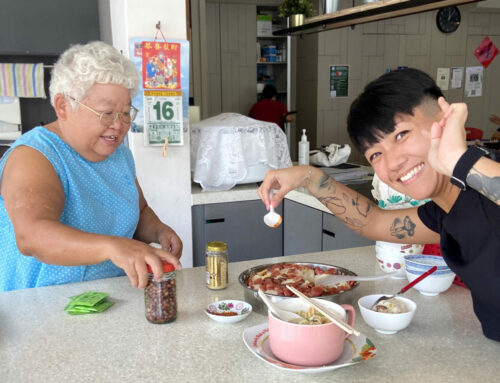Library / Project Journal
As the Tides Quell
Library / Project Journal
As the Tides Quell
By Salty Xi Jie Ng
24 May 2024
This post is part of a series on our Both Sides, Now project at Wellness Kampung @ 765 Nee Soon Central (2023-24). This year-long project aims to develop supportive communities for living well, and leaving well.

Senior collaborator Chia Yim Fong (3rd from right) and BSN volunteer Kaitlin Tay (4th from right) engage in end-of-life conversations with the public. Image by Zinkie Aw.
Looking back, there is a sense that something has been birthed after nine months together, sailing in an ocean exploring our shared mortality. The punctuation mark was twelve days in March, when the Wellness Kampung and its community welcomed almost 1400 people from all over Singapore, with a range of public and closed-door programmes. It was an intense period for everyone and a very new experience for the senior collaborators. What have we harvested, what remains and what may carry forward?
Expanding the ecology
In arts-based community development, there is a semi-private sphere that is unseen by the public, as well as secondary and tertiary audiences of the work. Much of the process takes place in this world before it opens up quite rapidly during a showcase period, if the project has one. As the tides exhibition neared, this world became larger in stages, bringing more and more people into its folds, eventually including the public who came to visit the cosmos we were building.

Senior collaborator Koh Tong Cheng shares about her short film Float Free during the volunteer training program. Image by Stacy Huang.
The first big enlargement of this sphere was in the training we conducted for docents, gallery sitters, and other volunteers, including staff of Yishun Health who were learning about arts-based approaches by being involved. The seniors shared about their projects while volunteers and staff took down anecdotes that they might want to share while giving tours. Later, seniors and volunteers paired up to practise and get to know each other. It was my first time learning about Both Sides, Now’s loyal tribe of volunteers, many of whom have been coming back for years, perhaps because they are interested in the topic and enjoy being around seniors. They are people from different walks of life, including an occupational therapist in training, a marketing executive, and a doctor. The training felt like a mini first public unveiling and I was heartened to receive these old timers’ excitement about the artworks, and that tides gave community creators more authorship and ownership.

Senior collaborators Devi Maniam (left) and Chia Yim Fong (right) make decorations for tides. Image by Salty Xi Jie Ng.
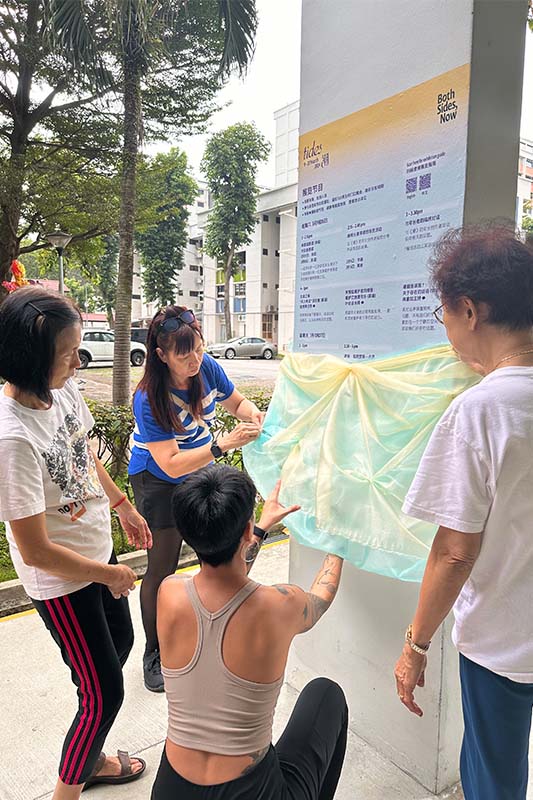
Senior collaborator Agnes Tan (left) and Assistant Artist/Spatial Designer/Production Manager Stacy Huang (centre) setup for tides with the aid of the Wellness Kampung Handicraft Club. Image by Salty Xi Jie Ng.
The exhibition setup, diligently led by Assistant Artist and Production Manager Stacy, was an opportunity for more community members to take a place in our expanding world. The centre buzzed with excitement as small transformations started to take place. Senior collaborator Shirley invited a close friend to join our installation of her seashell collection, travel photos, and statement on end-of-life plans. A couple of men from the centre’s Repair Kakis group —essentially a men’s club gathering nerdily over faulty appliances— aided with some assembly, a little step into our world although none had wanted to join Both Sides, Now. The centre’s handicraft group gave a lot of love and labour decorating the centre and surrounding pillars. And when the printing company had gotten senior collaborator Soh Joo’s artwork custom order wrong, I found myself being led by Centre Coordinator Mary to the nearby flat of a handicraft teacher and expert seamstress. I stood in her living room as she deftly and quickly pieced together fabric, marvelling at Mary’s immediate and available solution. Right after, senior collaborator Agnes ironed the fabric in her house, and we put it up just on time before The Straits Times photographer came to document Soh Joo’s installation. All the ways in which the community solves problems, provides, and supports each other lies at the heart of arts-based community development.
A punctuation mark, a blooming

Chia Yim Fong shares about her short film Float Free. Image by Zinkie Aw.
For the seniors, the exhibition was a time of blossoming, vulnerability, challenge, and opportunity, of being witnessed by family, friends, and community in their second home, the living site of the Wellness Kampung. They were sharing their artworks publicly, giving tours, answering questions on panels, engaging in end-of-life conversations and other conversation circles — things none of them had tried before.

Senior collaborator Lim Soh Joo engages in a one-on-one conversation at her installation Who Can Tell Me? Image by Zinkie Aw.

Senior collaborator Shirley Wong speaks during a panel discussion at tides. Image by Zinkie Aw.

One of many notes left by members of the public at senior collaborator Magdalene Yap’s installation. Image by Salty Xi Jie Ng.
Countless reflections about the artworks were shared by public visitors. Grandchildren wanted to write messages to their grandparents’ after seeing senior collaborator Devi’s artwork. People were inspired by the film about three seniors learning to swim in old age, moved by senior collaborator Magdalene’s caregiving story, curious about Agnes’ umbilical cord sculptures, encouraged by Shirley’s outspoken end-of-life planning, and tickled and ponderous at Soh Joo’s cosmic installation and persona. Notably, senior collaborator Michelle’s film aroused emotion, tears, and murmurs of “60% happiness”. She reflects, “I didn’t imagine it would make people cry…People approach the film differently depending on who they are and what pain they carry. It is not one-dimensional, it has different sides. It can activate people.”
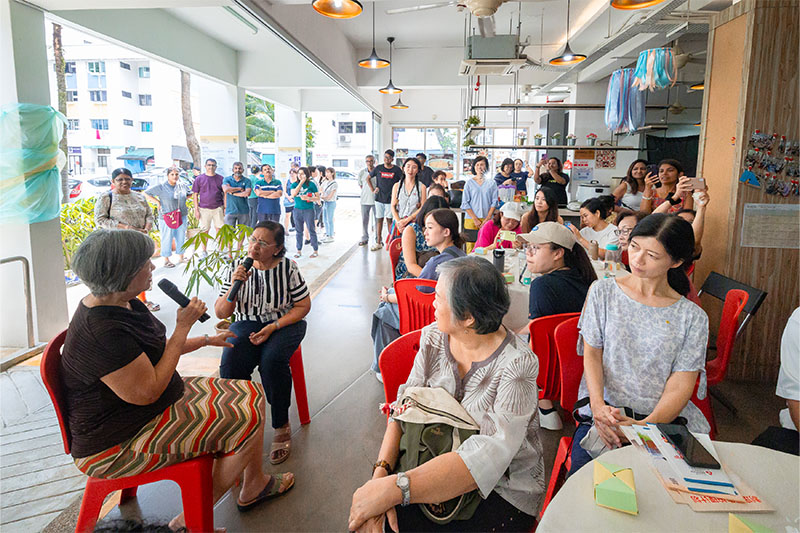
Magdalene Yap and Devi Maniam roleplay an end-of-life conversation between mother and child, while Devi’s family and members of the public watch. Image by Zinkie Aw.
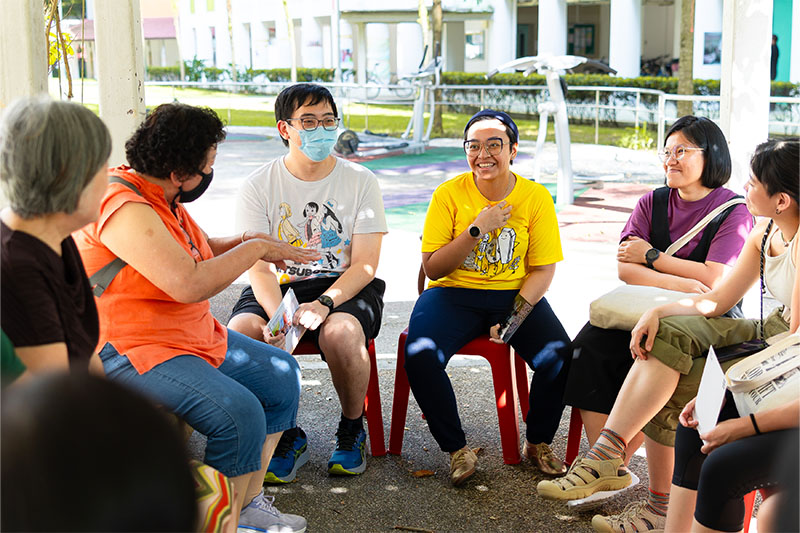
Magdalene Yap’s conversation circle on the ups and downs of caregiving. Image by Zinkie Aw.
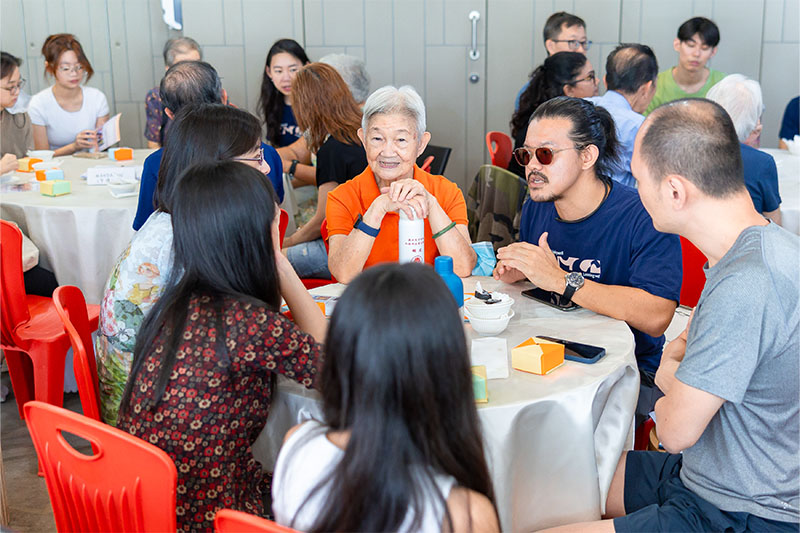
Koh Tong Cheng (centre) and BSN volunteer Ng Kok Ann (2nd from right) engage in an end-of-life conversation with members of the public. Image by Zinkie Aw.
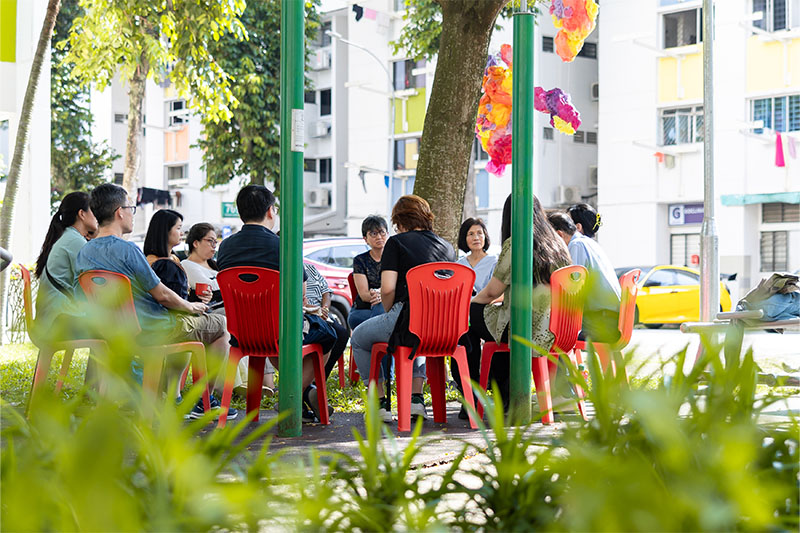
Agnes Tan’s conversation circle on speaking about end-of-life matters and saying goodbye. Image by Zinkie Aw.
Conversation was, and has always been, a big part of end-of-life exploration. It is in conversation where vulnerability is shared, intimacy is exchanged, feelings emerge and are held, and where understanding begins. Both Shirley and Michelle’s projects mention sea burials, inciting discussion on burial types throughout the exhibition. The senior collaborators presented end-of-life conversation role plays between mother and child, neighbours, friends, and loved ones. Devi’s tribe of over twenty family supporters watched her play a younger woman sad to hear her mother’s end-of-life plans. People huddled over comforting snacks and tea with seniors as BSN volunteers guided conversation among strangers. Agnes’ conversation circle discussed how to approach the taboo subject with loved ones, and saying goodbye. Magdalene’s conversation circle on caregiving held space for a lot of emotion and sharing around regrets, pain, guilt, and more, while brimming with self-affirmation and encouragement for caregivers to take care of themselves better. Magdalene reflected on feeling comforted by the circle, and inspired by a younger generation of caregivers more aware of their own needs than she has been of her own.

Devi Maniam with BSN volunteer Joeve Lio sharing about Lim Soh Joo’s artwork. Image by Salty Xi Jie Ng.
It was the first time in Both Sides, Now’s history that seniors guided tours. With the help of their partners, they took the plunge and waxed lyrical about their peers’ artworks and their own. Senior collaborator Yim Fong asked audiences if mothers kept umbilical cords; Devi shared her thoughts on Soh Joo’s existential questions. Senior collaborator Tong Cheng enjoyed ending her tours with a poetic summary, later reflecting, “The cycle of life is represented in this project. The journey through the artworks is a journey through life.”
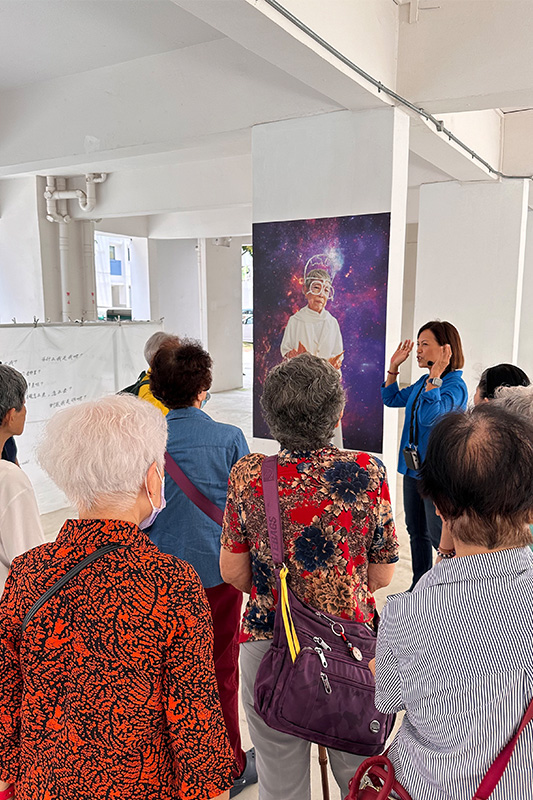
Senior collaborator Michelle Sim shares Lim Soh Joo’s cosmic installation with seniors visiting from other Wellness Kampungs. Image by Salty Xi Jie Ng.
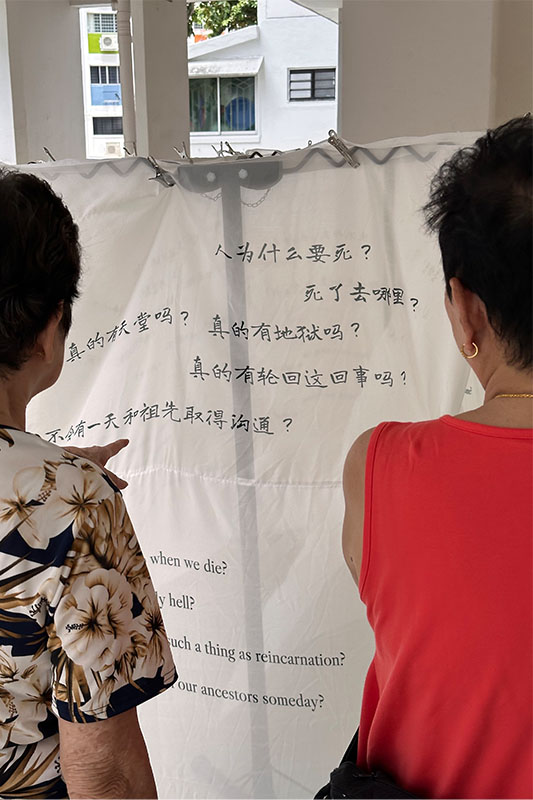
Seniors visiting from other Wellness Kampungs ponder cosmic philosopher Lim Soh Joo’s existential questions. Image by Salty Xi Jie Ng.
To provide opportunities for tides collaborators to be in conversation with their peers, seniors from other Wellness Kampungs were invited for a special programme. I loved seeing them ponder Soh Joo’s questions aloud as they circled the installation. Someone remarked that she found Soh Joo sassy; another said she wanted to be like her. Seniors from the neighbourhood also swarmed to the Mandarin version of the talk by Sister Sim Lai Kiow, a longtime palliative care nurse. She explained palliative care, Advance Care Planning (ACP), Lasting Power of Attorney (LPA) and other procedures related to end-of-life. In the first five minutes, one lady raised her hand and asked in Mandarin, “What about the thing where they can give you an injection to help you die?” There is so much more to uncover, and learn, about people’s concerns and questions with regard to leaving well.
The coral reef

BSN volunteers serve red bean soup made by a Wellness Kampung volunteer. Image by Zinkie Aw.
During the exhibition, Shirley invited her peers to pose with their artworks, took photos of them, and shared the photos in our group chat at the end of the day. At the post-exhibition group reflection, she appreciated every single person for their strengths. It is in these acts where she exemplifies roles like documenter, supporter, witness. Every role is important in the ecology of relations that make up a community development project, described by our Yishun Health project commissioner Dr Wong Sweet Fun as a coral reef attracting different marine species. Within this ecosystem, kindness multiplies on itself. A Wellness Kampung volunteer made a gigantic pot of red bean soup to feed visitors. The leftovers were brought home by Yim Fong to make kueh, which was brought the next day to be cut up and served by volunteers and seniors. And it goes on and on.
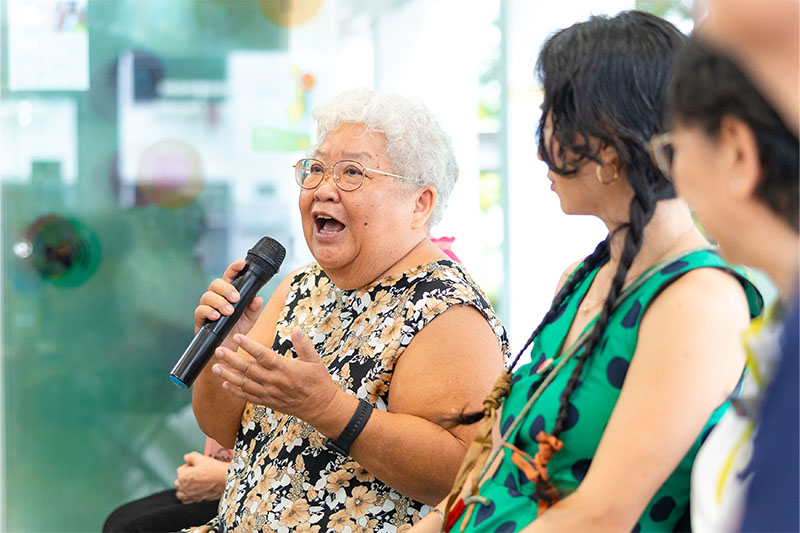
Chia Yim Fong answers a question at a panel discussion. Image by Zinkie Aw.
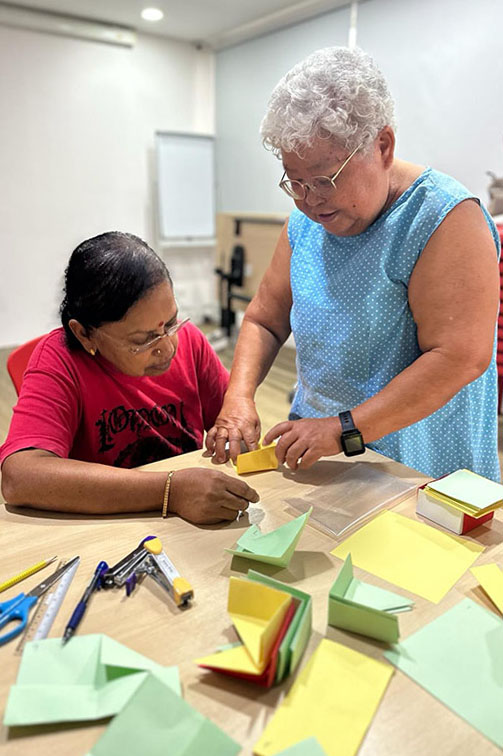
Chia Yim Fong (right) teaches Devi Maniam (left) how to fold gift boxes to be given to all BSN volunteers and visitors. Image by Salty Xi Jie Ng.
Yim Fong cherished the exhibition in her own way. With a quest to make gift boxes for every single tides volunteer and visitor, she mobilised her peers, working late into the night herself. She also used the exhibition as a platform to reunite with old friends who hadn’t seen her in years, some who came after seeing her in a newspaper article featuring tides. She said, “The two weeks of the exhibition were one of the happiest for me. I’ve not felt so happy in a long time. I’m so grateful to this platform. It’s a gift for my 70th birthday.”

Shirley Wong (centre) poses in front of her installation with staff of Yishun Health who guided tours with her: Ong Min Li (left) and Ng Wan Zhyi (right). Image courtesy Shirley Wong.
Within this ecology, staff of Yishun Health had the opportunity to experience another side of health by participating in the art-making process within their community, giving tours with seniors, and being docents for the exhibition. They remarked at the meaning they found, and how they got to see a new side to seniors they had known for years. Growing the ecology is not just about including more people but also about them growing parts of themselves, however small these new recognitions might be. Michelle reflected, “I didn’t know I was so humorous.”
Questions about art
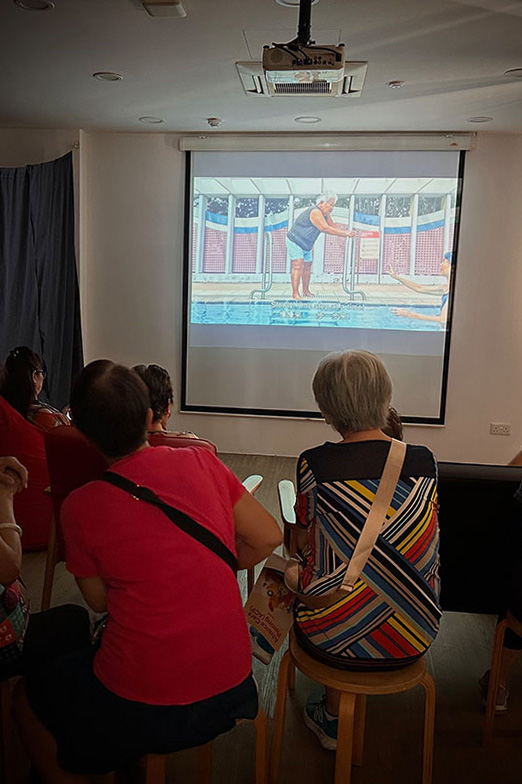
tides visitors watch Float Free in the screening room. Image by Salty Xi Jie Ng.
The centre’s main enclosed activities room was mildly transformed into a cosy screening room for watching tides’ short films. The only air-conditioned area in the exhibition, it became a quiet space of respite. Although this sort of spatial transformation is normal business for art practitioners, Centre Coordinator Mary said it was unimaginable, and now calls it the cinema. She marvels, “Nothing is impossible, it’s whether you want to change. My bookshelf can be Shirley’s art installation. The kitchen glass windows can put Devi’s artwork. This gives me new ideas for transforming the space.”
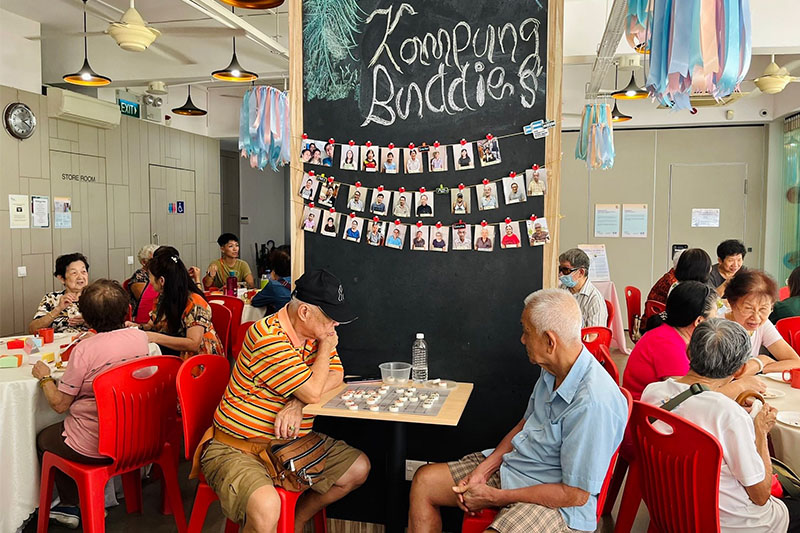
Wellness Kampung regulars play chess while tides’ programming takes place around them on a weekday. Image by Salty Xi Jie Ng.
We had wanted to share the space with Wellness Kampung regulars in an authentic way, hoping they would support their peers to have the special moment that is tides. Following a town hall to share about tides with the community, several activity groups had been asked to take a short pause. During the exhibition, two uncles were tucked nicely into an unused corner, playing their daily chess game amidst the bustle. Conversely, seniors who had daily sessions of rummy-o at the centre remarked matter-of-factly that they couldn’t play because our setup was there. Were we displacing some of them, in spite of our best intentions and efforts to communicate the purpose of the exhibition? Is it the artists’ role to find consensus within an existing community? Who really runs a space, and who is it for? How does art change spaces and people?
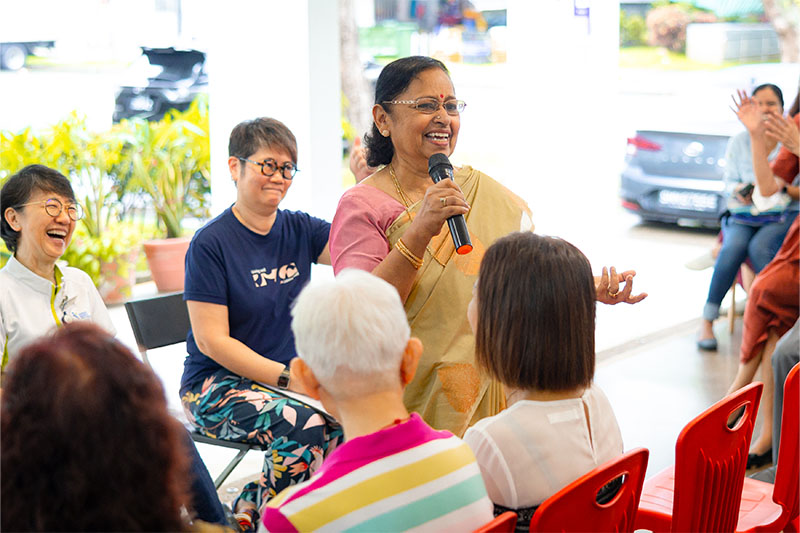
Devi Maniam shares about her journey through Both Sides, Now during a panel discussion. Image by Zinkie Aw.
One of my favourite moments in the exhibition was a revelation on repeat. When Devi was asked about her experience in the project, she would say, “At first, I didn’t want to talk about this subject, because it was so painful. But I told myself to be strong and carry on. Slowly, with the guidance of the artists who cared for us so well, I came around. Now I feel so strong and confident, so proud to be part of this. I never thought such a thing would happen in my life. This project is such a miracle for me.”
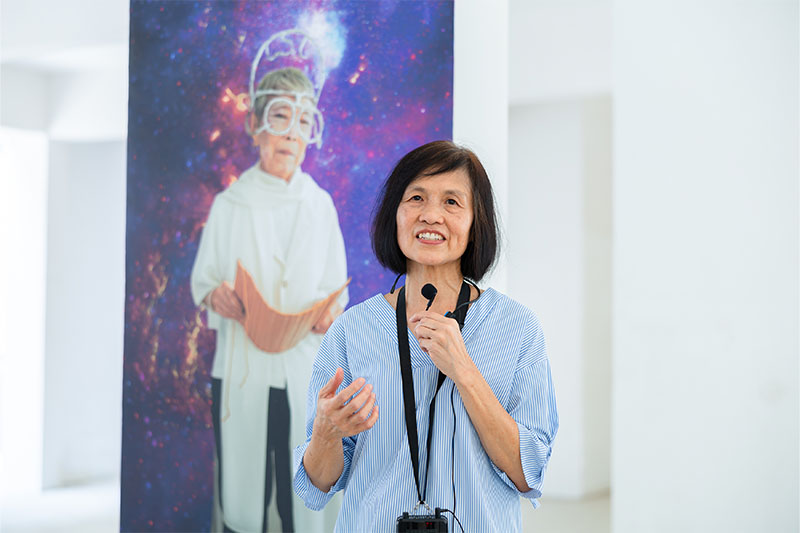
Agnes Tan leads a tour and shares Lim Soh Joo’s artwork. Image by Zinkie Aw.
During a question and answer session, an audience member asked the seniors what they think art is after being part of Both Sides, Now. Tong Cheng said, “Art is so curious and refreshing. It’s hard to grasp; it’s abstract. Art is in the everyday. Even a meal is art.” Soh Joo said, “Art is subjective. Something someone says is good art, someone else might not. But if you say something is art, it is art.” Michelle later added, “Art brought us to another space….the environment (is) softer, more tender.” I’d like to think that the lingering energies of tides allows for a gentle opening for more end-of-life conversations, and for creativity and imagination to be more present in people’s lives.
I am immensely proud of the seniors, and moved by what they have given and how they opened their hearts to myself, Stacy, each other, and the public. There is much to harvest and I have many questions, rightly so, to bring forward to the continuation of this work in a space that became my second home too. What does community-led really mean when a proposal with broad but foreclosed outcomes existed before the collaborators came onboard? When artists and arts producers enter a community, how does our presence change the space? How can we best facilitate opportunities for the community’s concerns and dreams to emerge? When we challenge community members, how do we find the right balance with their capacity, especially for seniors? How can arts practitioners do this work sustainably? Because relationships continue, does a project truly end?

Lim Soh Joo and Lead Artist Salty Xi Jie Ng at the former’s cosmic installation. Image courtesy Salty Xi Jie Ng.
As we wind down, I am attempting to make a weekly routine of swimming alongside some of the seniors at Yishun Swimming Complex. Recovering from my own burnout, I enjoy being a regular visitor to the pool on sunkissed mornings, floating past corners of the pool where we made our film, relishing in satisfaction and memories.
About Salty Xi Jie Ng
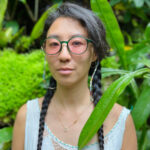
Salty Xi Jie Ng is the lead artist of Both Sides, Now 2023-24 at Wellness Kampung @ 765 Nee Soon Central. She is an artist and educator working intimately with people and their lives in relation with the other-than-human. The Grandma Reporter, her collaborative publication project about senior women’s culture across the earth, has explored style, intimacy and eroticism. She was commissioned by T:>Works Festival of Women N.O.W. to make Not Grey: Intimacy, Ageing and Being with elder Singaporean women.


